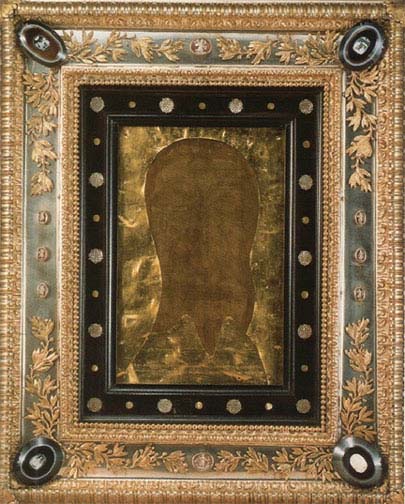
Veronica's Veil

The story of Veronica and her veil does not, in fact, occur in the Bible, though the apocryphal "Acts of Pilate" gives this name to the woman with a blood flow who was cured by touching the hem of Jesus' cloak. Critics of the incidents historicity point to the very name of the saint: "Veronica" is a combination of Latin and Greek words meaning "true image." Nonetheless, the story has been a part of popular Christian culture for centuries, including a brief scene in Zefferelli's "Jesus of Nazareth." Physical Features The almost transparent veil measures about 6.5 x 9.5 inches and bears dark red features of a bearded man with long hair and open eyes. The legend holds that Jesus rewarded Veronica's charity in wiping the sweat from his brow by imprinting his image into the cloth. The image on the Monoppello cloth becomes invisible depending on the angle from which the cloth is viewed."The fact that the face appears and disappears according to where the light comes from was considered a miracle in itself in medieval times," noted Pfeiffer. "There are few such objects in history. This is not a painting. We don't know what the material is that shapes the image, but it is the color of blood." Scientific Investigation Ultraviolet examinations of the cloth, carried out by Prof. Donato Vittore of the University of Bari, confirm that the image is not paint. Particularly noteworthy are several small flecks of reddish brown -- presumably drops of blood from the wounds caused by the crown of thorns. Enlarged digital photographs of the veil reveal that the image is identical on both sides of the cloth -- a feat impossible to achieve by ancient techniques. These photographs have also been used to compare the veil with the face on the Shroud of Turin, which millions of Christians believe to be Jesus' burial sheet. Striking similarities were apparent: the faces are the same shape, both have shoulder-length hair with a tuft on the forehead, and the beards match. Story of a Relic History records the existence of this relic from the fourth century, but only from the Middle Ages was it strongly linked to the Passion of Christ. From the 12th century until 1608, it was kept in the Vatican Basilica as a popular goal of pilgrims, mentioned in Canto XXXI of Dante's "Paradise." When the part of the Basilica containing the relic was scheduled to be torn down for remodeling, the relic disappeared overnight.
Visit [saintpetersbasilica.org]. |